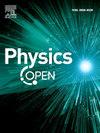Rabi oscillations and entanglement between two atoms interacting by the Rydberg blockade studied by the Jaynes–Cummings Model
IF 1.4
Q2 Physics and Astronomy
引用次数: 0
Abstract
The interaction between atoms and a quantized radiation field is fundamentally important in quantum optics and quantum information science. Due to their unusual properties, Rydberg atoms are promising building blocks for two-qubit gates and atom-light quantum interfaces, exploiting the Rydberg blockade interaction which prevents two atoms at close distance () from being simultaneously excited to Rydberg states. Recently, this effect was used to engineer quantum processors based on arrays of interacting Rydberg atoms illuminated by Raman lasers. Motivated by these experiments, we extend the Jaynes–Cummings model to study the interaction between two Rydberg atoms interacting by the Rydberg blockade and a quantized radiation field. We consider both number (Fock) states of the field and single-mode quantum coherent states. In particular, we discuss different types of entanglements between various components of the total system consisting of the two Rydberg-interacting atoms and coherent states of the field, and show that the behavior is significantly different compared to a system with non-interacting atoms corresponding to the two-atom Tavis-Cummings model. Our results are relevant in view of atom-light quantum interfaces as components for future long-distance quantum communication.
用jines - cummings模型研究了两个原子之间的Rydberg阻滞相互作用的拉比振荡和纠缠
原子与量子化辐射场之间的相互作用在量子光学和量子信息科学中具有重要意义。由于其不寻常的性质,里德伯原子是两量子比特门和原子-光量子界面的有希望的构建块,利用里德伯封锁相互作用,防止两个距离近(<10μm)的原子同时被激发到里德伯态。最近,这种效应被用于设计基于拉曼激光照射下相互作用的里德伯原子阵列的量子处理器。在这些实验的激励下,我们扩展了jines - cummings模型来研究两个Rydberg原子在Rydberg封锁和量子化辐射场相互作用下的相互作用。我们考虑了场的数态(Fock)和单模量子相干态。特别地,我们讨论了由两个rydberg相互作用的原子和场的相干态组成的总系统的不同组分之间的不同类型的纠缠,并表明其行为与对应于双原子Tavis-Cummings模型的非相互作用原子的系统相比有显着不同。我们的研究结果对原子-光量子接口作为未来远距离量子通信的组成部分具有重要意义。
本文章由计算机程序翻译,如有差异,请以英文原文为准。
求助全文
约1分钟内获得全文
求助全文
来源期刊

Physics Open
Physics and Astronomy-Physics and Astronomy (all)
CiteScore
3.20
自引率
0.00%
发文量
19
审稿时长
9 weeks
 求助内容:
求助内容: 应助结果提醒方式:
应助结果提醒方式:


